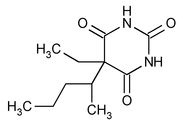Pentobarbital
C11H18N2O3 226.27
2,4,6(1H,3H,5H)-Pyrimidinetrione, 5-ethyl-5-(1-methylbutyl)-, (±)-;
(±)-5-Ethyl-5-(1-methylbutyl)barbituric acid

 [76-74-4].
[76-74-4].
(pen'' toe bar' bi tal).
C11H18N2O3 226.27
2,4,6(1H,3H,5H)-Pyrimidinetrione, 5-ethyl-5-(1-methylbutyl)-, (±)-;
(±)-5-Ethyl-5-(1-methylbutyl)barbituric acid
DEFINITION
Pentobarbital contains NLT 98.0% and NMT 102.0% of C11H18N2O3, calculated on the dried basis. Where the material is labeled as intended solely for veterinary use, Pentobarbital contains NLT 97.0% and NMT 102.0% of C11H18N2O3, calculated on the dried basis.
IDENTIFICATION
• B.
The retention time of the major peak of the Sample solution corresponds to that of the Standard solution, as obtained in the Assay.
ASSAY
• Procedure
Mobile phase:
0.01 M monobasic potassium phosphate and acetonitrile (65:35). Adjust the pH to 3.5.
Standard solution:
0.1 mg/mL of USP Pentobarbital RS in Mobile phase
Sample stock solution:
1 mg/mL of Pentobarbital in Mobile phase (sonicate until dissolved)
Sample solution:
Transfer 10.0 mL of the Sample stock solution to a 100-mL volumetric flask, and dilute with Mobile phase to volume.
Chromatographic system
Mode:
LC
Detector:
UV 214 nm
Column:
4.6-mm × 25-cm; 5-µm packing L1
Flow rate:
1 mL/min
Injection size:
10 µL
System suitability
Sample:
Standard solution
Suitability requirements
Column efficiency:
NLT 15,000 theoretical plates
Tailing factor:
NMT 1.5
Relative standard deviation:
NMT 2.0% for pentobarbital
Analysis
Samples:
Standard solution and Sample solution
Calculate the percentage of C11H18N2O3 in the portion of Pentobarbital taken:
Result = (rU/rS) × (CS/CU) × 100
| rU | = | = peak area from the Sample solution |
| rS | = | = peak area from the Standard solution |
| CS | = | = concentration of USP Pentobarbital RS in the Standard solution (mg/mL) |
| CU | = | = concentration of Pentobarbital in the Sample solution (mg/mL) |
Acceptance criteria:
98.0%–102.0% of C11H18N2O3 on the dried basis; and 97.0%–102.0% of C11H18N2O3 on the dried basis, where the material is labeled as intended solely for veterinary use
IMPURITIES
Organic Impurities
• Procedure
Mobile phase:
Prepare as directed in the Assay.
Standard solution:
0.001 mg/mL of USP Pentobarbital RS in Mobile phase
Sample solution:
1 mg/mL of Pentobarbital in Mobile phase
Chromatographic system
Mode:
LC
Detector:
UV 214 nm
Column:
4.6-mm × 25-cm; 5-µm packing L1
Flow rate:
1 mL/min
Injection size:
10 µL
System suitability
Sample:
Standard solution
Suitability requirements
Column efficiency:
NLT 15,000 theoretical plates
Tailing factor:
NMT 1.5
Relative standard deviation:
NMT 15.0% for pentobarbital
Analysis
Samples:
Standard solution and Sample solution
Calculate the percentage of any impurity in the portion of Pentobarbital taken:
Result = (rU/rS) × (CS/CU) × (1/F) × 100
| rU | = | = peak area for any impurity from the Sample solution |
| rS | = | = peak area for pentobarbital from the Standard solution |
| CS | = | = concentration of USP Pentobarbital RS in the Standard solution (mg/mL) |
| CU | = | = concentration of Pentobarbital in the Sample solution (mg/mL) |
| F | = | = relative response factor of the impurity (see Impurity Table 1) |
Acceptance criteria:
See Impurity Table 1.
Impurity Table 1
| Name | Relative Retention Time |
Relative Response Factor |
Acceptance Criteria, NMT (%) |
|---|---|---|---|
| 6-Imino-5-ethyl-5- (1-methyl butyl) barbituric acid |
0.39 | 1.5 | 0.2 |
| 5-Ethyl-5-(1-ethylpropyl) barbituric acida | 0.93 | 1.0 | 0.1 |
| Pentobarbital | 1.0 | — | — |
| 5-Ethyl-5-(1,3-dimethylbutyl) barbituric acid |
1.5 | 0.9 | 0.3 |
| Unknown impurities | — | 1.0 | 0.1 |
| Total | — | — | 0.5 |
|
a
Where the material is labeled as intended solely for veterinary use, the limit of 5-ethyl-5-(1-ethylpropyl) barbituric acid is 3.0%.
|
|||
SPECIFIC TESTS
• Loss on Drying  731
731 :
Dry a sample at 105
:
Dry a sample at 105 for 2 h: it loses NMT 1.0% of its weight.
for 2 h: it loses NMT 1.0% of its weight.
ADDITIONAL REQUIREMENTS
• Packaging and Storage:
Preserve in tight containers.
Auxiliary Information—
Please check for your question in the FAQs before contacting USP.
| Topic/Question | Contact | Expert Committee |
|---|---|---|
| Monograph | Hariram Ramanathan, M.S.
Associate Scientific Liaison 1-301-816-8313 |
(SM42010) Monographs - Small Molecules 4 |
| Reference Standards | RS Technical Services 1-301-816-8129 rstech@usp.org |
USP35–NF30 Page 4263
Pharmacopeial Forum: Volume No. 35(4) Page 864

